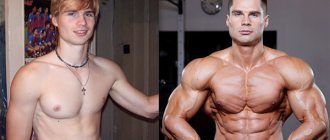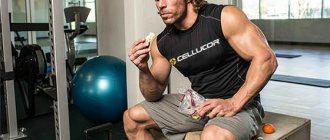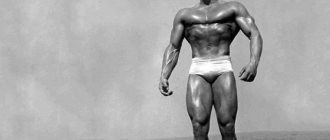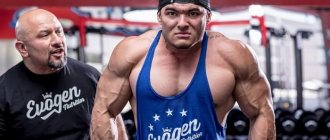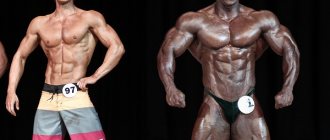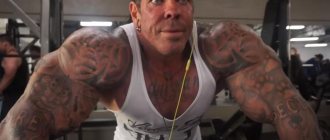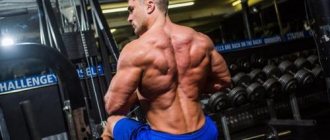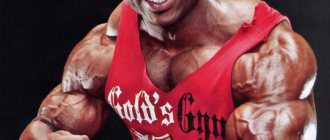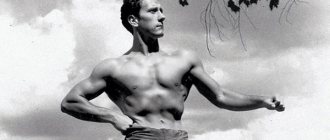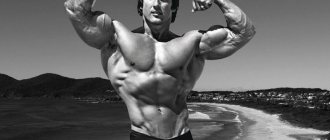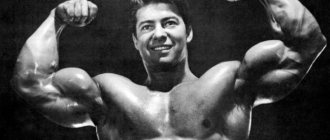Jeff Seid anthropometry: Height – 183 cm, Competition weight – 93 kg, Biceps – 46 cm, Chest – 130 cm, Waist – 76 cm,
First place at “IFBB Stockholm Pro” – 1 time.
Seid's biography pages
Jeffrey Seid was born on June 12, 1994 in Renton, Washington. At the age of 5 he began to be interested in sports. Dad sent the boy to the athletics section and football. By the time he was a teenager, he had become familiar with the biographies of weightlifting champions and their training. The desire to please girls pushed me to pick up the shells. I received a set of sports equipment as a gift from my parents for my 12th birthday.
An innocent hobby soon grew into a serious hobby and took up all my free time. However, Jeff stubbornly dreamed of becoming a football player. He was driven by ambition and the desire to “leave behind a long memory.” The guy actively trained and played in the city’s national football team. For this he received a scholarship that allowed him to pay for his studies at college. Everything was going great until Jeff tore his cruciate ligament . After rehabilitation, 2 months later, the story repeated itself. This forced me to finally change the type of sports activity.
Wednesday: Legs/Calves/Cardio
Not a superset:
- Squats: 5 sets of 15, 10, 8, 6, 4
Superset:
- Front squats: 4 sets of 12, 10, 8, drop set 8, 6
- Hack machine: 4 sets of 12, 10, 8, drop set 8, 6
Not a superset:
- Leg press: 4 sets of 10, 8, 8, 6
Superset:
- Extensions: 4 sets of 12, 10, 8, 8
- Curls: 4 sets of 12, 10, 8, 8
Not a superset:
- Standing calf raises: 4 to 15
- Incline calf raises: 4 to 15
- Seated calf raise: 4 to 15
Successes of the handsome guy in Men's Physique
By the will of fate, he began to participate in beach bodybuilding competitions. Even before the first operation, the guy drew attention to the new category “Mens Physicist” on the website bodybuilding.com. This is where 6 years of experience in carrying iron came in handy. At the premiere performance he took a prize. A year later, he received professional status and became the youngest member of the IFBB federation. 2012-13 became key in a sports career. Jeff Seid often competed and never finished lower than 2nd place. In 2014, it dropped down one notch. However, the performance at Olympia was unsuccessful; it was not possible to rise above the 11th position.
Seid took a break and began shooting for the covers of Iron Man and Men's Fitness. Wrote a book with a step-by-step guide for bodybuilders, was involved in business . In 2016, he competed in Stockholm Pro with renewed vigor and won , beating Anton Antipov and Denis Gusev. Jeff Seid continues to train hard in 2017-18 and is preparing to conquer the Olympia.
| Year | Competitions | Place |
| 2012 | NPC Vancouver & Tanji Johnson Classic Men's Physique | absolute champion |
| 2012 | NPC Emerald Cup Men's Physique | 2 |
| 2012 | Southern Championships | absolute champion |
| 2012 | Washington State Championship | absolute champion |
| 2012 | NPC US Championship | 5th place in class D |
| 2012 | IFBB North American Championships | 2nd place in class B |
| 2013 | Jr. Nationals | absolute champion |
| 2013 | IFBB Pro Wings of Strength | 1 |
| 2013 | IFBB Tampa Pro | 2 |
| 2013 | IFBB Europa Supershow | 6 |
| 2013 | IFBB Pro Venti Gold Cup | 1 |
| 2013 | IFBB Olympia Men's Physique | 11 |
| 2014 | IFBB Europa Show of Champions | 5 |
| 2014 | IFBB Prestige Crystal Cup | 4 |
| 2014 | IFBB Greater Gulf States Pro | 2 |
| 2014 | IFBB Tampa Pro | 11 |
| 2014 | IFBB Dallas Pro | 3 |
| 2014 | IFBB Olympia Men's Physique | 13 |
Jeff Seid Performance History
| Tournament | Category | the date of the | Country and city | Place |
| Mr Olympia 2016 | Men's Physique | 2016 | Las Vegas, USA | 16 |
| Mr Olympia 2014 | Men's Physique | 2014 | Las Vegas, USA |
“Without proper nutrition, I would go nowhere”
Based on his own bad experiences, Jeff recommends creating a menu based on your body composition and experimenting with diet options. Although his diet contains a lot of sports nutrition, the main mission in building strong muscles is given to nutrition.
“My favorite supplement is a gainer. I can’t eat constantly to gain the required 5000 kcal, so I choose sports drink with a minimum of sugar. I make sure that the composition contains complex carbohydrates and proteins that promote mass gain, not weight.”
Jeff doesn't take pre-workout supplements and advises "spending your money on good food" instead. Doping recommends taking it in case of acute lack of energy.
Athlete's menu:
- Steamed oatmeal with banana + egg whites + Animal Pak, Chromium Picolinate.
- Gainer + milk + spoon of flaxseed oil.
- Poultry or fish + brown rice.
- Before work: Nutrex Hemorage Black.
- During - Optimum Nutrition BCAA.
- After that - a portion of gainer + banana + creatine + vitamin C.
- A protein dish with a side dish of complex carbohydrates.
- Casein protein + ZMA before bed.
The best exercises for the abdominal muscles and oblique muscles!
0
You may also be interested in "Men's Physique" 0
Jaco De Bruyn WBFF PRO Jaco De Bruyn WBFF PRO Professional athlete fitness model Jaco de “Men's Physique” 0
Gerardo Gabriel IFBB PRO Gerardo Gabriel IFBB PRO Professional athlete fitness model competitor Arnold classic Most Popular
bar, header training programs>header>
How much does a barbell weigh?
Training programs
Arnold Schwarzenegger training program
"Bikini"
Ekaterina Usmanova
Training programs
Home training program for teenagers 11-17 years old
Jeff Seid and his hardcore training program
“I change it constantly to make the muscles grow. The jock intuitively senses when the muscles get used to it and radically changes the pattern. I just pump my abs for 15 minutes without stopping, choosing exercises according to my mood.”
The weekly plan is based on local training and supersets.
On Monday the focus is on the ankles and torso. In respect of:
- Dumbbell lateral raises and bench presses with a medium grip and a raised back;
- “Butterfly” and bench press on a horizontal surface;
- upside down presses + dips;
- “donkey” climbs;
- press work
On Tuesday, my legs were targeted. Jeff uses:
- front squats and classic barbell squats;
- hack squats and bench curls while lying on the machine;
- platform presses.
He devotes Wednesday to working on his hands from different angles. In complex:
- biceps and triceps curls while sitting and lying down;
- work in the Scott machine + classic French barbell press + isolated biceps curls;
- working out the abdominal muscles.
On Thursday, according to the schedule, spin. In a programme:
- deadlift;
- chin-up rows and head pull-ups;
- horizontal rows of a block to the chest with a wide grip + pull-ups;
- T-bar row and lat row
- press.
On Friday, pump up delta trisets with the help of:
- swinging dumbbells in front of you and to the sides from a straight position and in an inclined position;
- pull to the chin;
- shrugs with a barbell.
Sixth day - repeat the program of the first day. On Sunday it is restored, then repeats the program in a circle.
Monday: Chest/Calves/HIIT
Superset:
- Bent-over barbell press: 4 sets of 10, 8, 8, drop set 6, to failure
- Incline dumbbell flyes: 4 sets of 10, 10, 8, 8
Not a superset:
- Block crossover: 4 sets of 15, 10, 8, drop set 8, to failure
Superset:
- Dumbbell bench press: 4 sets of 10, 8, 8, 6
- Bars: 4 to failure
Superset:
- Incline press (on a machine): 3 sets of 10
- Push-ups: 3 sets to failure
Not a superset:
- Pullover: 3 to 15
- Standing calf raises: 4 to 15
- Incline calf raises: 4 to 15
- Seated calf raise: 4 to 15
Sources of vitamins
Fruits
Firstly. Citrus fruits, kiwi, apples, and cranberries especially contain vitamin C. Apricots are rich in potassium and magnesium, while pomegranates contain large amounts of iron.
Fresh vegetables
- tomatoes, carrots, spinach are rich in antioxidants, carotenes, and tomatoes are a storehouse of lycopene.
Onions, garlic and herbs
- the richest source of a number of essential microelements, vitamins, antioxidants, phytoncides and other substances. They help to cope with stress (and every hard workout is stress for the body), increase the body’s resistance and endurance, strengthen the immune system and have a number of other beneficial effects on the athlete’s body.
Was this article helpful? Not really
Ask a baseball fan to name a lineup of the all-time greats at each position, and he might sprain a lobe trying to choose among Mays, DiMaggio, and Mantle in center. Boxing fans could easily name a dozen great fighters of yesteryear, throwing out names like Louis, Dempsey, and Marciano. I'm sure hockey fans could name ... some important hockey guys from 60 years ago.
But ask fans of bodybuilding to name some key figures who were around before the 1960s or “70s, and chances are they”d draw a blank once they got past Sandow and Reeves. Bodybuilding may not be a traditional sport like baseball, boxing, or hockey, but it’s something we’re all passionate about, and it has a rich history going back to the “physical culture” boom of the early 1900s.
Randy Roach's ambitious text, aims to correct that mistake. Roach spent more than five years interviewing, reading, researching, and tracking down 500 cited references" worth of details to explain the origins of bodybuilding, including a look at the earliest supplements, the magazines, and, most important, the basis for nutritional practices still used today.
MS&M
, at 594 pages, is just the first of three volumes; the other two are well underway. But perhaps the most amazing aspect of the project is that the 49-year-old Roach went blind halfway through writing the first volume. He'd had impaired vision since he was 2, a result of Stevens-Johnson Syndrome, but his vision failed permanently in 2005.
I caught up with Roach – a computer programmer by trade – by phone at his home in Waterloo, Ontario, where, despite his visions problem, he trains himself and clients in the fully equipped gym in his basement.
Q: You set out to research the roots of the iron game, and to figure out who first did the things that we all still do today. Why was that important? Why'd you take on such a huge task?
A: I was originally asked by the Price Foundation to do an article on the history of nutrition in bodybuilding, and I thought, “Okay, it should be fairly straightforward.”
It just started coming together, and it was a huge project. I really thought I was going to do this in one volume, but now it’s going to be three volumes, all pushing 600 pages.
Completely losing my eyesight in the beginning of 2005 made it that much more difficult. It was really frustrating, because I was always able to read with magnifiers and closed circuit TVs, but that was pulled right out from under me. I had to go all audio, and have people reading to me and preparing data.
It probably sped me up in the long run, because I was starting to get bogged down in a lot of peripheral reading. I didn't really need to go that deep into the rabbit trails, so it probably got me back on line.
Q: One of those rabbit trails is the conflict between Bob Hoffman of York Barbell and the Weiders. It was really a battle for the soul of strength training. Hoffman advocated training for performance, and the Weiders catered to guys who wanted to train for shape.
A: You're right, it was two philosophies. One was based in weightlifting, the other was based in pure bodybuilding. That went back to the 1920s, with Jowett and Calvert.
Calvert actually had a similar philosophy to Jowett in the beginning, but he changed his way when he read about calisthenics and high-rep training. The Weiders took that “train for shape, and strength will follow” route.
Hoffman, as a weightlifter, never believed in just building muscles for muscles" sake. He wanted those muscles to do
something, while Alan Calvert said, “For every one man who wants to be as strong as Sandow, I”ll show you a hundred who want to
look
like him.”
I think Calvert was probably more accurate. Everybody wants that look of muscle with the six-pack, veins in the biceps, all that stuff. But Hoffman lived and breathed weightlifting. I give him credit, he did a lot for the sport of American weightlifting. He took on an entire nation, the Soviet Union, in the 1940s and “50s.
When supplements came in, that was such a financial bonanza for Hoffman and Weider. They just took it and ran with it. The info ads didn't begin in the '90s, they started back in the '50s.
Q: But by starting Muscular Development
in 1964, Hoffman did eventually cater to bodybuilders.
A: He had no choice, because as much as he didn’t like bodybuilding, he knew it served him through merchandising. Especially when the supplements came out, it was the bodybuilders that he catered to. It was really good business. It was a wise move for Hoffman to create Muscular Development
and put John Grimek in as the editor.
Grimek was a good guy, a weightlifter and
a bodybuilder.
Q: Let's talk about those early supplements.
A: A lot of the early protein stuff came from industrial waste. The soy was soy meal runoff from the soy industry that was extracting the oils for paints and grease.
The meal was used to fertilize the ground, or they were feeding it to animals. They shouldn't really have been feeding it to the animals either. It was controversial at the time because they were de-fatting it with solvents, and they were toxic.
Hoffman was bragging that he wasn’t using solvents or de-fatting his, but he was left with unstable oils. That's when they started hydrogenating them, to try to stabilize it, but Hoffman had the full meal and his fats were becoming rancid. You had to keep his protein in the refrigerator.
A lot of those early protein powders were highly questionable.
Q: I was caught by surprise by the emphasis on eating uncooked food among some bodybuilders. Armand Tanny, who passed away recently, was a raw foodist. You're also a raw-food eater, right?
A: Yeah. Armand liked me because I eat meat raw, like he did.
He was wrestling in the Hawaiian Islands in the late '40s, and he was impressed with the Samoans, who were eating raw meat, raw beetles, raw fruit. He said they were so strong and healthy that he just came home, shut off his stove, and within two years he walked away with the Mr. USA and the Pro Mr. America.
George Hackenschmidt was an advocate of raw foods. He didn't really say that he ate raw meat, but he drank a lot of raw milk. Vince Gironda heavily promoted raw milk and cream over pasteurized. Vince would eat steak tartare and raw eggs. At first he was cooking his eggs, but later he started advocating raw eggs.
Q: Another topic you cover is the argument over full-body training vs. body-part splits. We think it's a relatively new argument, but in your book you show that lifters were fighting over this 50 or 60 years ago. When did split training come about? Did it start with the steroid era?
A: It started before the drugs. People will argue when drugs came into the sport – whether they were using Methyltestosterone in the late “40s or early “50s is debatable – but they weren’t using synthetic derivatives such as Dianabol or Nilivar at that time.
That differentiation began in the late «40s and early «50s. George Jowett and Alan Calvert began the three-days-a-week, total-body, double-progressive system, and it was held for many years.
Modern bodybuilding really took off in 1939 and 1940, when the AAU came in to run the Mr. America. They took weightlifting out of the prerequisites for it, so you had guys training just for the physique.
The Weider gang, with Clancy Ross and those guys later in the “40s, began to do more specialized training, to get some volume in. Hoffman also followed suit to a certain degree, but he wasn’t going to let himself get too close to Weider.
Steroids in bodybuilding didn't really
come into play until the early «60s. They were dabbling with it through the “50s, but by then, the training had already differentiated into a more volume style. They"re calling it "flushing" and "pumping." They were arguing whether cheating was any good. Things like that.
Q: It seems like some people were writing about steroids in the “40s, but it wasn’t until the late “50s when they were introduced to athletes.
A: They weren't writing about them in the iron game in the 1940s. Paul de Kruif wrote The Male Hormone
in 1945, singing the praises of Methyltestosterone and Testosterone replacement for those medically in need. There were some inklings about, “Well, what could it do for a healthy person?”
I know Irvin Johnson had possession of Nilivar between 1956 and “58, when it just came out. Bill Pearl said he first interacted with Nilivar in 1958. But one of the first articles on it, in 1962, was titled something like, “Please Guys, Don't Do It.” It was [ Ironman
publisher] Peary Rader warning against the effects of steroids.
They had already proliferated into high schools and college football at that time. It wasn't in bodybuilding strictly. It was starting to get into all the strength- and speed-oriented sports right from the get-go.
Q: You mentioned Irvin Johnson. Aside from his expertise in nutrition and early supplementation, he also created Tomorrow's Man
, a physique magazine aimed at the gay male audience.
Was that what motivated Joe Weider to start magazines like Adonis
and ? Was he trying to capture a part of the gay market and compete with Johnson? And is this one of the reasons why Bob Hoffman went after Weider with such personal venom?
A: Hoffman was really frustrated with Joe. Was Joe a bodybuilder first, or was he a businessman first? Did he have a homosexual orientation, or would he just stop at nothing to make money, in any market?
Weider lost and Adonis
around 1956-57, when American News went under. But he started right up again in 1961 with another two magazines. So, they were obviously making him money.
The industry is saturated in its peripherals with homosexuals. Even Dan Lurie said back in the “40s that all the photographers he knew were gay. Into the “50s and “60s, nothing really changed. I chose the “50s to deal with it because Peary Rader was addressing it, and Bob Hoffman was addressing it with “Let Me Tell You a Fairy Tale.”
Peary was worried about the bodybuilders becoming what he called “strutting egotists,” wearing tank tops, showing off, and basically having shallow personalities. He thought they should be rounded individuals. Remember, physical culture was mind, body, and spirit. But he was also worried about them taking that next step and prostituting themselves.
Everyone knows that it's still in the industry now, but it's in other sports too. It's not limited to bodybuilding. It's there in all endeavors that have young, healthy bodies, whether they have pronounced musculature or just have a good athletic look. And when money's involved, it's going to be there.
Q: Does your research give you some insight as to where things are going in the next decade or two?
A: The sport's already come back around on its ass again. It's gone full-circle, and it's dying off. Teenagers aren't getting into the sport. They're migrating to MMA. They're not going to take the amount of drugs that they need to. They can get the physique they want without taking all that.
Nobody's going to the competitions. The audience is dying off. There’s no creativity anymore – it’s just gone since DeMilia left.
But I can't be a hypocrite. I»ma natural bodybuilder, but I was attracted to the sport, as a kid, by bodybuilders who were taking steroids. I thought they looked great. It's their business if they want to take them, but where they've gone today, it's absolutely insane.
How many genetically gifted athletes got to the bodybuilding table, said “No freaking way!” and walked? It takes a certain mindset to say, “I”ll do that. I'll take all that stuff, just to maybe
be one of the top 10 guys and make some money." It's crazy.
As long as that faction of bodybuilding is flown as the flagship of the sport, you can kiss it goodbye. It"ll never completely disappear, but they"ve got to start getting more marketable athletes. Someone who's going to draw the kids in, and the women in. Like DeMilia said, “You know you”re going the wrong way when the homosexuals say, “We”re not coming either.” "
I feel sorry for athletes today in the sense that, if you want to be a doctor or a dentist or a lawyer, if you have the brains and you can get the money to go to school, you can become that.
If a young athlete has the gifts, the genetics, and the resources, that’s not enough. He also has to make that decision. “Will I take drugs to perform at the top level?” No other profession is required to do that, only athletics.
And then we chastise the athletes. Corrupt politicians scold them in these hearings. It's just all wrong. The whole black market thing, the ban … that"sa whole other political argument that I think should be left alone right now.
Q: What surprises are we going to find in Volume Two?
A: People were very good in stepping forward and divulging information that's not been told before. Again, the backdrop theme of the whole series is nutrition, but nutrition won’t be as heavily in it as the first volume. It's still there, for sure, and it'll pick up again in Volume Three.
Volume Two is about those glory years of bodybuilding – the “70s and the “80s.” It was a good time for bodybuilding. I cover the power transfer from York to Weider, and control of bodybuilding with the AAU and the NPC. There'sa lot of activity going on. The bulk of the steroid issue will be covered in Volume Three, but it's still covered in Volume Two.
You're going to find out who the real mechanics were, who moved bodybuilding along behind the scenes. Guys that didn't get the glory and still aren't getting the recognition today, but without them, it would've been a whole different landscape.
Again, bodybuilding was a business
, but it struggled to define itself. Was it a pageant? Was it a sport? Was it a circus? Was it some kind of hybrid of those? It was an avenue for just a small number of people to make money, and others were trying to proliferate and build it into a reputable sport.
I'm going to cover who was trying to move it in those directions, what was blocking it, and who was benefiting. Yeah, there's definitely contest-fixing, everyone knows that, but it's to the extent
that they were being fixed. There have been some very transparent, terrible bodybuilding decisions, right through all the decades.
It’s too bad, because the vast majority of people can’t pick a winner in bodybuilding anyway, so you don’t have to
have the same guy winning at all costs to sell your merchandise. The whole lineup looked fantastic in those days, and any one of them could sell the merchandise. They didn't have to fix the damn shows.
Q: I think all the behind-the-scenes politics is something the average fan never really expects, but when I interviewed and recently, they both mentioned it. A lot of it is literally involved in politics, especially when it concerns Sergio Oliva.
A: In 1962, we had just got through the Cuban Missile Crisis. Do you think Joe Weider is going to take a black Cuban who can barely speak English over Dave Draper, who had that California look with a great physique?
I have a chapter in Volume Two called “Arnold”s Cuban Muscle Crisis,” about the battle between him and Sergio, and what happened in Tijuana in 1973, with that contest and the fixing.
Q: When will Volume Two come out?
A: I should have Volume Two out in the first half of next year.
Actually, TC will be in Volume Three. Before I got into the third volume, I tried to unravel the Met-Rx/EAS quagmire, and then I realized I couldn’t do it all in one volume, so I left off around there.
I don’t have as much material yet for Volume Three. That's going to be very political, and I'm going to see where we are in the world, in terms of where the laws are. In order for people to understand what could
happen to the supplement industry, and how it will also affect the food that we eat and our food supply, they have to understand the globalization process.
Q: Thanks for taking the time to put it all together, and thanks for sharing your time with T Nation readers.
Dreams that crumble
Around the time that coincided with the end of three years of high school, he could boast of incredible success in the path of sports. Everything was given to the ambitious Jeff: wrestling, football, running records. Achievements made it possible to apply for a scholarship, and not without results. It was this money that made it possible to easily afford higher education, as Seid notes.
Dreams collapsed, as it happens, one day, shattered by a sports injury. First football game, senior year, torn ACL. This period of life was dominated by depression and melancholy; the young man, accustomed to the fact that his life consisted of physical activity, was literally suffocating from sadness. First, my desire to play sports in college was reduced to smithereens. Secondly, goodbye scholarships. Accordingly, there was no talk of paying for higher education. A few months later the ligament was torn again. According to Jeff, he “finally decided that life was over. Heh..."

